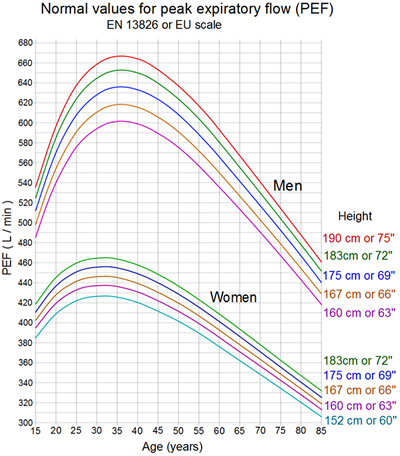Normal Peak Expiratory Flow (PEF)
Peak Expiratory Flow (PEF), also called Peak Expiratory Flow Rate (PEFR) is a person’s maximum speed of expiration, as measured with a peak flow meter like the unit available from Activ8rlives. This is a small, hand-held device used to monitor a person’s ability to breathe out air. It measures the airflow through the bronchi of the lungs and thus the degree of obstruction in the airways.
Peak flow readings are higher when we are well, and lower when the airways are constricted. From changes in recorded values, we may determine lung functionality, severity of asthma symptoms, and treatment options.
Measurement of PEFR requires some practise to correctly use a meter and the normal expected value depends on a patient’s gender, age and height. It is classically reduced in obstructive lung disorders, such as Asthma, COPD or Cystic Fibrosis.

Due to the wide range of ‘normal’ values and high degree of variability, peak flow is not the recommended test to identify respiratory disease. However, it can be useful in some circumstances to monitor the severity of it or efficacy of treatment. It is important to use the same peak flow meter every time to ensure consistency of the readings.
The Normal value (Target value) for PEF varies according to gender, age and height. This chart can be used to read-off your Normal value. Enter this value in your “Target PEF.” data field.
Peak flow readings are often classified into 3 zones of measurement according to the American Lung Association; green, yellow, and red. Doctors and health practitioners develop management plans based on the green-yellow-red zones.
Green Zone: 80 to 100 percent of the usual or normal peak flow readings are clear. A peak flow reading in the green zone indicates that the lung function management is under good control.
Yellow Zone: 50 to 79 percent of the usual or normal peak flow readings indicates caution. It may mean respiratory airways are narrowing and additional medication may be required.
Red Zone: Less than 50 percent of the usual or normal peak flow readings. Indicates a medical emergency. Severe airway narrowing may be occurring and immediate action needs to be taken. This would usually involve contacting a doctor or hospital.
If in doubt, contact your medical team for advice.
